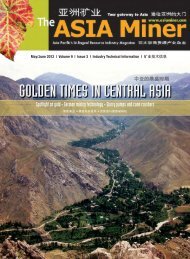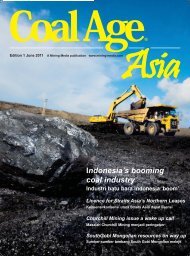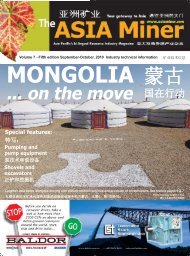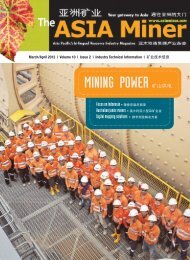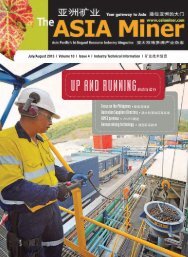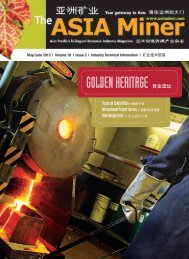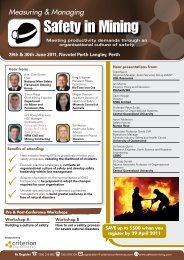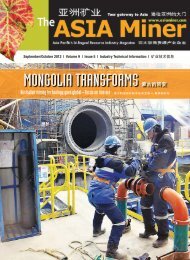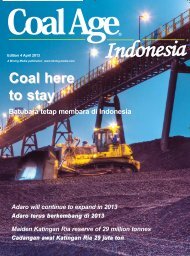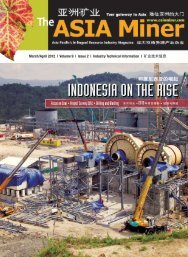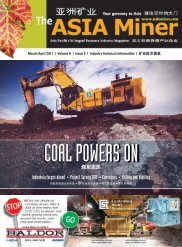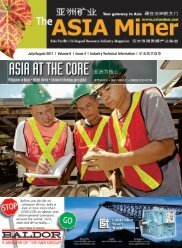MINING WELCOME 欢迎采矿 - The ASIA Miner
MINING WELCOME 欢迎采矿 - The ASIA Miner
MINING WELCOME 欢迎采矿 - The ASIA Miner
Create successful ePaper yourself
Turn your PDF publications into a flip-book with our unique Google optimized e-Paper software.
Central Asia<br />
Studies boost value of Shambesai project<br />
MANAS Resources’ Shambesai Gold Project<br />
in the Kyrgyz Republic is expected to generate<br />
net cash flows of up to US$190 million during<br />
the first five years of production, with more<br />
than 200,000 ounces of gold being produced.<br />
A revised mining evaluation and pit optimization<br />
study has upgraded the project’s potential,<br />
with increases to throughput, cash flows<br />
and mine life prompted by further oxide ore<br />
discoveries and future sulphide ore treatment.<br />
Estimated net cash flows attributable to indicated<br />
oxide resource material only totals<br />
more than US$137 million over five years with<br />
a further possible US$53 million from inferred<br />
oxide resource. <strong>The</strong> current probable reserve<br />
of oxide material is estimated to be 180,000<br />
ounces over the five-year mine-life with the<br />
potential of a further 40,000 ounces from currently<br />
inferred oxide material that is contained<br />
within the pit shell.<br />
Annual production is expected to peak at<br />
50,000 ounces in year 3 and average 40,000<br />
ounces for the five years of the projected<br />
mine life from the indicated and inferred oxides.<br />
More than 75,000 ounces of gold contained<br />
within sulphide material stockpiled<br />
during oxide mining is not included in the<br />
cash flow estimates. Cash costs are estimated<br />
at US$370 per ounce for the first four<br />
years and US$465 per ounce for life-of-mine.<br />
Manas’ managing director Stephen Ross<br />
says, “We are extremely pleased with the updated<br />
cash flow numbers from the pit optimization<br />
study which, when compared to the<br />
November 2010 scoping study, demonstrate<br />
that we can expect a much improved production<br />
rate and subsequent improved cash flows<br />
for the Shambesai shallow oxides alone.<br />
“Despite this conservative approach to the<br />
mining plan focusing on the near-surface<br />
oxide material only, project cash flows from<br />
the updated pit optimization work have almost<br />
doubled. We look forward to the granting<br />
of our mining licence and an early move<br />
into the implementation phase of the<br />
Shambesai gold project.”<br />
Shambesai is in the Tien Shan Belt and is<br />
expected to be one of the world’s lowestcost<br />
gold operations. Manas is the largest<br />
and most active gold explorer in the Kyrgyz<br />
Republic with nine projects under exploration.<br />
<strong>The</strong> company’s second largest gold project,<br />
Obdilla, is 7km from Shambesai and has a resource<br />
estimate of 485,000 ounces.<br />
<strong>The</strong> project’s feasibility study, which was<br />
scheduled for completion by the end of 2011,<br />
includes the recently completed mining evaluation<br />
and pit optimization study as well as<br />
basic engineering for the proposed processing<br />
plant and updated capital and operating<br />
costs. In September, Shambesai was upgraded<br />
to an indicated and inferred resource<br />
of 11.6 million tonnes @ 2.1 grams/tonne<br />
gold for 766,000 ounces of gold.<br />
An impression of the mineral inventory in the preliminary pit at Manas’ Shambesai project.<br />
Raisama lifts Kashkasu interest to 97.5%<br />
RAISAMA Limited has completed the acquisition<br />
of a further 22.5% interest in the<br />
Kashkasu II Uranium Project in the Kyrgyz<br />
Republic from Orca Energy and now holds<br />
97.5%. This acquisition has removed any future<br />
joint venture funding issues that may<br />
have arisen given Orca no longer considered<br />
its interest in this project as a core asset.<br />
As part consideration for the purchase of<br />
this further interest Raisama has issued<br />
870,000 fully paid shares to Orca. Moving to<br />
a 97.5% position will allow the ASX-listed<br />
company to plan the future of the project with<br />
a greater degree of certainty.<br />
Raisama has completed its 2011 field season<br />
exploration activities at the Kashkasu II<br />
project, including its phase 4 drill program.<br />
This program targeted down-dip and structural<br />
extensions of the known mineralization<br />
within the Turakavak formation.<br />
Due to difficult conditions in the uranium<br />
market as a result of the Fukushima Nuclear<br />
incident the company decided to halt the program<br />
after completing four holes. Despite<br />
that, the drilling intersections have more than<br />
doubled the known extent of mineralization<br />
down-dip, with economic uranium mineralization<br />
at depths of up to 394 metres.<br />
<strong>The</strong> best drill intersection was 10 metres @<br />
2130 ppm U3O8 and this section included 0.5<br />
metres @ 14,458 ppm U3O8. <strong>The</strong> highest individual<br />
assay was 14,941 ppm U3O8, or<br />
1.5% U3O8, from 274.5 metres to 274.75 metres<br />
depth down hole. A total of four mineralized<br />
zones were encountered within this hole,<br />
including the deepest of the project so far.<br />
Uranium is present both in sandstone and<br />
coal-bearing beds of the Turakavak formation.<br />
Structural interpretation has also highlighted<br />
the potential for additional zones of mineralization<br />
to be present due to folding and possible<br />
thrust faulting of the mineralized stratigraphy.<br />
January/February 2012 | <strong>ASIA</strong> <strong>Miner</strong> | 47



